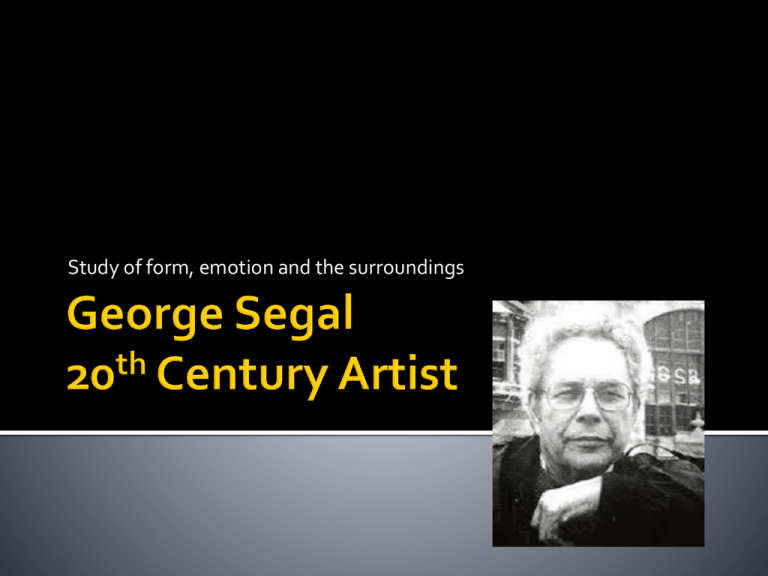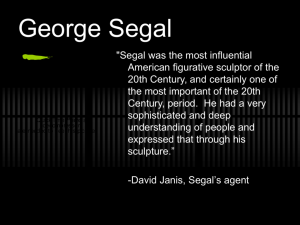George Segal PPT 2
advertisement

Study of form, emotion and the surroundings Painter 1950’s started figurative painting Early work considered pop art Sculptor Examined relationship of fine art to popular art forms Reference to individual place in mass culture life-size plaster human sculptures Human figures in space and related surroundings Influenced by Edward Hopper Attention to attitude and gestures Rural and urban settings Nighthawks (1942) close up CAPE COD MORNING ROOM IN BROOKLYN ROOM IN NEW YORK SUMMER EVENING SUMMER IN THE CITY SUNDAY Cast plaster molds of living figures Attempt to lock to them in time in constructed environment Select situation Select a person and pose Cast figure, sometimes in clothing Soaked bandages in plaster and applied and shaped them to the body Man Sitting at a Table (1961) Used only outside unpainted surface of cast Abstract, impressionistic, disembodied and anonymous quality//depersonalized social settings MAN SITTING AT A TABLE (1961) NOTICE! simple almost sterile environment anonymous//depersonalized nature abstract and impressionistic What is the emotional quality? What do you think about when you view this? Parking Garage (1968): Poured industrial plaster inside cast to capture details of expression and physical form: more life-like The Corridor (1976): cast and painted in vivid colors as metaphors for “rosy disposition” “blue funk” and “a black mood” PARKING GARAGE (1968) THE CORRIDOR (1976) Fragments and groups of figures in social settings Sound and lighting effects Cast still-life scenes from works by major modern artists: Picasso’s Chair (1973) GEORGE SEGAL PICASSO’S CHAIR (1973) PABLO PICASSO THE CHAIR Similarities? Differences?? 1. Choose either half figure or full figure to cast in plaster using plaster strips. 2. Cut the strips into three long smaller strips. 3. Apply Vaseline thoroughly to all skin that will be covered by the strips or tape plastic over clothing. 4. Wet strips and wrap them, one by one, around one body section at a time until it is completely covered 5. Let strips heat up and dry. (may need hair dryer to speed the drying process) 6. Cut slits down the side to remove body part (i.e. arm) 7. Carefully remove the hardened plaster surface 8. Repair slit with strips or pure wet plaster 9. Can (not at all required) paint sculpture when it dries From this To this Kristine Stiles. “Segal, George.” Grove Art Online. Oxford Art Online. 25 Nov. 2008 Images <http://www.oxfordartonline.com.proxy.lib. muohio.edu/subscriber/article/grove/art/T0 77360> Images: www.metmuseum.rog/…/ 2000/images/2001.57.L.jpg http://www.artres.com






![First Aid Training : Bronze [Power Point]](http://s2.studylib.net/store/data/005424634_1-e0b0e5e602f7c1666ebc2e9ff3f4a1b5-300x300.png)




